Drakesbrook Weir
Please note the following in relation to the Drakebrook Weir Dam:
MARINE SAFETY
SUMMARY OF GAZETTAL NOTICES AND AREAS
February 27, 2017
METRO – PEEL
DRAKESBROOK DAM
CLOSED WATERS – MOTORISED VESSELS
All waters of the Drakesbrook Dam are hereby closed to motor boats (excluding electric powered).
Published : 30/9/05
Construction of the Weir
In 1931 the construction of the Waroona Weir commenced and it was completed in 1932. The Weir was constructed mostly by hand, with a small amount of machinery. Shovels, picks, wheelbarrows and a small bulldozer were used in its construction. The workers camped in tents, or if they were lucky, they owned one of the three houses close by. Most of the workers were locals. Work was hard and living conditions were just as hard.
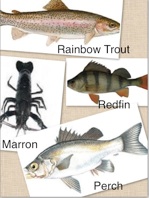
Creatures and measurements
The Weir holds 2,290 ML but it only has 1870 ML of water in it at present. The catchment area of the Weir is 5900 hectares and has a surface area of 417 hectares.
The Drakesbrook Weir is an irrigation weir, which collects the water overflow from the Waroona Dam. Farmers used the water for their livestock and crops. The Weir is a home to Rainbow Trout, Redfin, Perch and Marron. Some of those creatures are hard to find.
Upgraded facilities and things to do
The Weir has just had a makeover and now has upgraded toilets facilities, swimming area, shady parking, beach sand, solar lighting, barbecues and shelters. The Weir is a great place to have a barbecue, picnic or just a relaxing swim. There is a pontoon to keep the children entertained. The children use the pontoon for jumping off or having wrestling matches with the loser falling into the water. These are some of the activities the Weir is used for: Swimming, canoeing, swimming classes, school swimming carnivals, bushwalking and fishing. Sometimes events like Australia Day celebrations, family picnics and raft building competitions were held there. Powerboats and dogs are prohibited at the Weir.
_scaled.JPG)
Noisy Scrub Bird
 The first discovery of the Noisy Scrub bird was made in Waroona by John Gilbert and James Drummond in 1842. It was discovered in Drakes Brook Valley. The birds were rarely seen; so many people thought they were extinct. 1n 1961, the Noisy Scrub bird was rediscovered in Albany. The Noisy Scrub Bird is a small solidly built bird, with a strong pointed bill, powerful legs, graduated tail and short round wings. They are brown above white with a dark cross barring extending from its head to the tip of its tail. The bird is semi-flightless and only weighs 35-55g. It eats ants, beetles and spiders. It lives in the trees near the water, scavenging for bugs and other food. The Noisy Scrub Bird was rereleased by Alcoa in the late 1990’s to increase numbers in the wild.
The first discovery of the Noisy Scrub bird was made in Waroona by John Gilbert and James Drummond in 1842. It was discovered in Drakes Brook Valley. The birds were rarely seen; so many people thought they were extinct. 1n 1961, the Noisy Scrub bird was rediscovered in Albany. The Noisy Scrub Bird is a small solidly built bird, with a strong pointed bill, powerful legs, graduated tail and short round wings. They are brown above white with a dark cross barring extending from its head to the tip of its tail. The bird is semi-flightless and only weighs 35-55g. It eats ants, beetles and spiders. It lives in the trees near the water, scavenging for bugs and other food. The Noisy Scrub Bird was rereleased by Alcoa in the late 1990’s to increase numbers in the wild.
Six Season Artwork
The Shire of Waroona respectfully acknowledges the traditional custodians of the land on which we live and work, the Bindjareb people of the Noongar nation. We recognise their continuing connection to land, waters, and culture, which has existed for thousands of years. We pay our respects to their Elders past, present, and emerging, and extend that respect to all Aboriginal and Torres Strait Islander peoples in the community. We commit to working in partnership with the Bindjareb people to build a more inclusive and harmonious future for all.
The Bindjareb people's traditional lands encompass areas around the Peel-Harvey Estuary, Murray River, Harvey River, and Serpentine River. These lands are rich in biodiversity and have been vital for the Bindjareb people's cultural practices and sustenance. The Bindjareb people have their own distinct language and cultural practices, which are part of the broader Noongar culture. Language and cultural knowledge have been passed down through generations, playing a significant role in maintaining connections to land, spirituality, and community.
Like many Aboriginal and Torres Strait Islander groups in Australia, the Bindjareb people faced significant challenges during the colonial period, including dispossession of their land, disruption of cultural practices, and mistreatment by settlers. This history has had lasting impacts on Bindjareb communities and their ongoing struggle for recognition, rights, and social justice.
Today, many Bindjareb people continue to reside in Waroona and surrounding areas, maintaining connections to their culture and country. Efforts to revitalise language, cultural practices, and traditional knowledge are ongoing. The Shire of Waroona are proud to support this effort by working closely with the community to support their needs and aspirations while we collaborate and build stronger, more equitable relationships.
Noongar Six Seasons artwork
The following artwork has been created by Shardah Jetta-Farmer and is displayed on the BBQs and the ablution block at the Drakesbrook Weir. The paintings bring the Noongar calendar to life and showcase the six distinct seasons that shape the landscape and cultural practices. The colours and symbols tell stories of centuries-old traditions and the deep ecological knowledge of the Bindjareb people.
Makuru – Season of Fertility
Winter: June-July
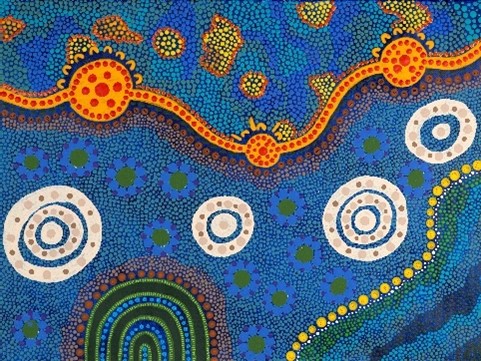
Makuru is a cold and wet time of year when the Bindjareb people would head up the scarp to hunt and gather in the hills. It is a time of fertility and an abundance of water. This painting showcases the full waterways, vibrant colours of the season and the significance of the Weir as a meeting place.
Djilba – Season of Conception
First Spring: August-September
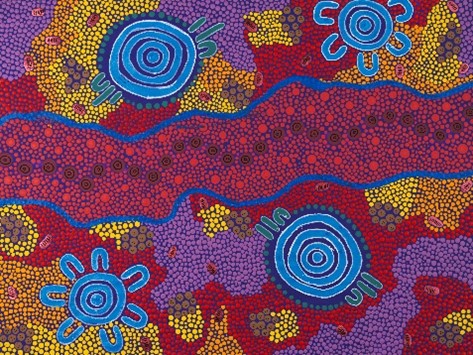
Djilba is a time of the year where some days are cold and clear others are warm and sunny, and you still get the occasional windy rainy day. Bindjareb boodja turns yellow as the Acacias begin to explode into bloom. This painting shows the colours of the season, as the Weir comes to life and the birds and bees enjoy the abundance around the Weir.
Kambarang – Season of Birth
Second Spring: October-November
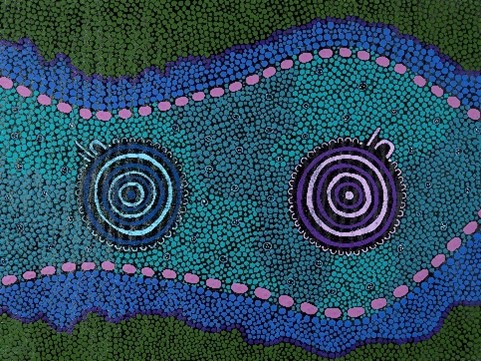
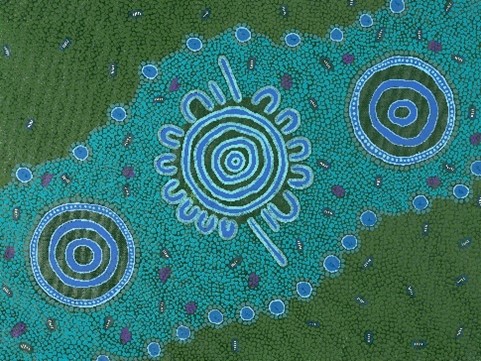
Kambarang is greeted by a surge of wildflowers. Bindjareb people knew to step carefully during this season, as snakes are awoken from their slumber by the change to warmer weather. These paintings represent nature in bloom at the Weir, the colours of the water, and the meeting place for men and women and birth.
Birak – Season of the Young
First Summer: December-January
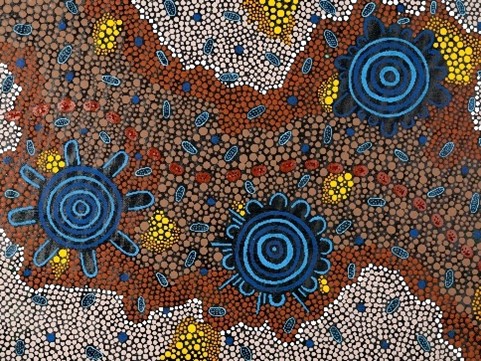
Birak season sees the rivers slow and the land start to dry. The water ways have had their fill, and the warm weather is making its mark. Bindjareb people know this is the time to look after their boodja and slowly burn the scrub that has built up in previous months. This painting shows the earth under the weir with no water. This is a memory from the artist when the Weir was drained many years ago.
Bunuru – Season of Adolescence
Second Summer: February-March
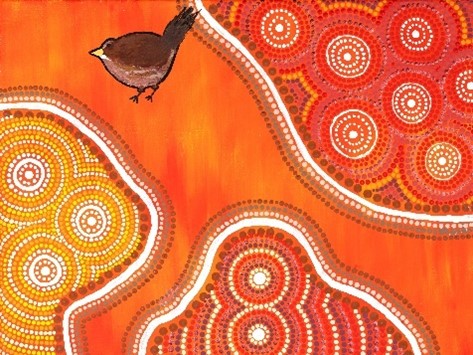
Bunuru is the hottest of the seasons and is a time when rain is scarce. Hot easterly winds flow down the scarp and signal a time for Bindjareb people to make their way to the coast where they will be greeted by the cooling sea breeze. This painting highlights the heat of the season and the importance of the Weir as a meeting place by the water. It also depicts the endangered Noisy-Scrub bird, that you may be lucky enough to see if you take a walk by the weir.
Djeran – Season of Adulthood
Ant Season: April-May
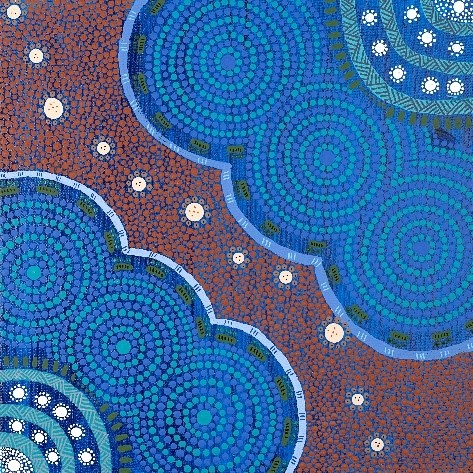
During Djeran the start of cooler weather is accompanied by flowering gums, banksias, and seeds on the sheoaks. Small mammals and birds can be seen making the most of this throughout the scarp’s jarrah forests. It is a time when the Bindjareb people would sure up their mia mia’s in preparation for the rains that will become more frequent. This painting represents the break in the hot season, growth and moving into adulthood.